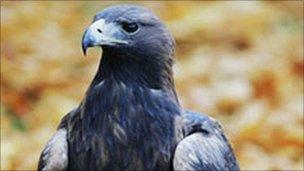Golden eagles given added protection in Scotland
- Published

The change will bring about 80 breeding territories into the current network
Scotland's golden eagle population has been granted extra protection.
The Scottish government said special protection area (SPA) status would cover six new sites where the birds of prey are known to exist.
The 350,000 hectares of northern and western Scotland includes parts of the Cairngorms, Moidart and Glen Etive and is in addition to eight older sites.
It is thought there are currently about 450 breeding pairs of golden eagles in the UK.
Environment Minister Roseanna Cunningham said it was fitting that additional steps had been taken to protect what was becoming one of Scotland's "most iconic species".
She added: "People come here from across the world with the hope of catching just a glimpse of one of these beautiful birds in their natural environment. These new protected areas will mean they can continue to do this for generations to come."
The golden eagle prefers the wild countryside of peatlands, uplands and mountains, but is threatened by habitat change and inappropriate development.
'Totemic birds'
The new protection areas will encompass Glen Affric in the central Highlands to Strathconon in Ross-shire, the Cairngorms Massif, Foinaven at Durness, and Moidart and Ardgour near Fort William.
The fifth additional area is from Glen Etive near Bridge of Orchy to Glen Fyne near Arrochar, and the sixth covers Jura, Scarba and the Garvellachs off the west coast.
The change will bring an estimated 80 additional golden eagle breeding territories into the current network.
Susan Davies, Scottish Natural Heritage's north areas director, said the new sites would make a significant contribution to Scotland's, and Europe's, conservation efforts to support birds of prey.
She added: "These totemic birds deserve special efforts to support their conservation.
"Along with other birds of prey, golden eagles can bring benefits to the local economy through wildlife watching; a recent study by SNH shows that nature-based tourism brings at least £1.4bn a year to the Scottish economy, supporting the equivalent of 39,000 jobs."